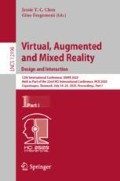Abstract
Human-Robot cooperation (HRC) is the developing trend in the field of industrial assembly. Design and evaluation of the HRC assembly workstation considering the human factor is very important. In order to evaluate the transformational construction scenario of a manual assembly workstation to a HRC workstation fast and safely, a HRC assembly simulation system is constructed which is based on Augmented Reality (AR) with human-in-loop interaction. It enables a real operator to interact with virtual robot in a real scene, and the assembly steps of real workers can be restored and mapped to a virtual human model for further ergonomic analysis. Kinect and LeapMotion are used as the sensors for human-robot interaction decision and feedback. An automobile gearbox assembly is taken as an example for different assembly task verification, operators’ data are collected and analyzed by RULA scores and NASA-TLX questionnaires. The result shows that the simulation system can be used for the human factor evaluation of different HRC task configuration schemes.
Access this chapter
Tax calculation will be finalised at checkout
Purchases are for personal use only
References
Matsas, E., Vosniakos, G.C.: Design of a virtual reality training system for human–robot collaboration in manufacturing tasks. Int. J. Interact. Des. Manuf. (IJIDeM) 11(2), 139–153 (2017). https://doi.org/10.1007/s12008-015-0259-2
Wang, Q., Cheng, Y., Jiao, W., Johnson, M.T., Zhang, Y.: Virtual reality human-robot collaborative welding: a case study of weaving gas tungsten arc welding. J. Manuf. Process. 48, 210–217 (2019)
Neuhoefer, J.A., Kausch, B., Schlick, C.M.: Embedded augmented reality training system for dynamic human-robot cooperation. Nato Research and Technology Organization Neuilly-Sur-Seine, France (2009)
Ni, D., Yew, A.W.W., Ong, S.K., Nee, A.Y.C.: Haptic and visual augmented reality interface for programming welding robots. Adv. Manuf. 5(3), 191–198 (2017). https://doi.org/10.1007/s40436-017-0184-7
Michalos, G., Karagiannis, P., Makris, S., Tokçalar, Ö., Chryssolouris, G.: Augmented reality (AR) applications for supporting human-robot interactive cooperation. Procedia CIRP 41, 370–375 (2016)
Crick, C., Jay, G., Osentoski, S., Pitzer, B., Jenkins, O.C.: Rosbridge: ROS for Non-ROS users. In: Christensen, H.I., Khatib, O. (eds.) Robotics Research. STAR, vol. 100, pp. 493–504. Springer, Cham (2017). https://doi.org/10.1007/978-3-319-29363-9_28
Azuma, R.T.: A survey of augmented reality. Presence: Teleoper. Virtual Environ. 6(4), 355–385 (1997)
Plopski, A., Moser, K.R., Kiyokawa, K., Swan, J.E., Takemura, H.: Spatial consistency perception in optical and video see-through head-mounted augmentations. In: 2016 IEEE Virtual Reality (VR), pp. 265–266. IEEE (2016)
Zhu, W., Fan, X., Zhang, Y.: Applications and research trends of digital human models in the manufacturing industry. Virtual Real. Intell. Hardw. 1(6), 558–579 (2019)
Hornung, A., Wurm, K.M., Bennewitz, M., Stachniss, C., Burgard, W.: OctoMap: an efficient probabilistic 3D mapping framework based on octrees. Auton. Robots 34(3), 189–206 (2013). https://doi.org/10.1007/s10514-012-9321-0
Nguyen, V.T.: Enhancing touchless interaction with the leap motion using a haptic glove. University of Eastern Finland, Joensuu (2014)
Hart, S.G., Staveland, L.E.: Development of NASA-TLX (Task Load Index): results of empirical and theoretical research. In: Advances in Psychology, North-Holland, vol. 52, pp. 139–183 (1988)
Qiu, S., Fan, X., Wu, D., He, Q., Zhou, D.: Virtual human modeling for interactive assembly and disassembly operation in virtual reality environment. Int. J. Adv. Manuf. Technol. 69(9–12), 2355–2372 (2013). https://doi.org/10.1007/s00170-013-5207-3
Acknowledgement
The work is partially supported by the NSFC project (51475291) and MIIT project (19GC04252), China. The authors are grateful to the editors and anonymous reviewers for their valuable comments.
Author information
Authors and Affiliations
Corresponding author
Editor information
Editors and Affiliations
Rights and permissions
Copyright information
© 2020 Springer Nature Switzerland AG
About this paper
Cite this paper
Wang, Q., Fan, X., Luo, M., Yin, X., Zhu, W. (2020). Construction of Human-Robot Cooperation Assembly Simulation System Based on Augmented Reality. In: Chen, J.Y.C., Fragomeni, G. (eds) Virtual, Augmented and Mixed Reality. Design and Interaction. HCII 2020. Lecture Notes in Computer Science(), vol 12190. Springer, Cham. https://doi.org/10.1007/978-3-030-49695-1_42
Download citation
DOI: https://doi.org/10.1007/978-3-030-49695-1_42
Published:
Publisher Name: Springer, Cham
Print ISBN: 978-3-030-49694-4
Online ISBN: 978-3-030-49695-1
eBook Packages: Computer ScienceComputer Science (R0)

